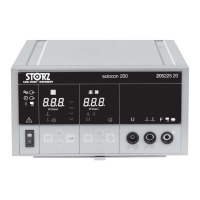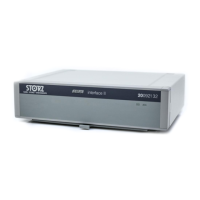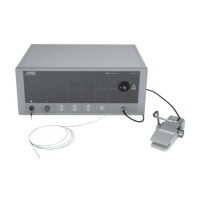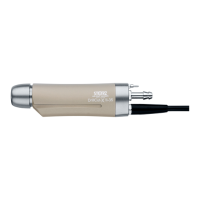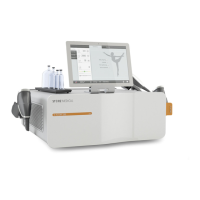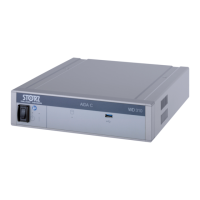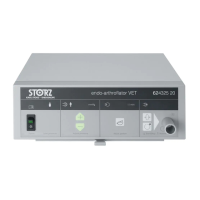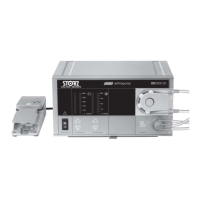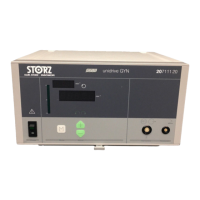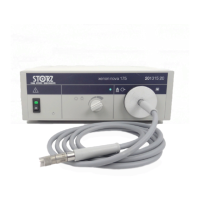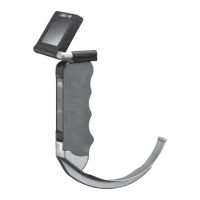Do you have a question about the Storz AUTOCON II 400 and is the answer not in the manual?
Provides initial welcome and confidence in the KARL STORZ brand.
Advises users to be trained and follow instructions carefully.
Details the function of each control element, display, and connector on the device.
Explains various symbols used in the manual and on the device interface.
Explains how HF current is used for tissue separation and coagulation.
Describes the vaporization of tissue fluid and arc formation during cutting.
Explains the thermal effects of HF current on tissue at different temperatures.
Introduces three main coagulation modes: Standard, Forced, and Spray.
Details Standard, Forced, and Spray coagulation techniques and their applications.
Discusses parameters influencing tissue cutting and the role of modern HF units.
Highlights the unit's versatility, precise settings, and safety features.
Defines the meanings of "Warning", "Caution", and "Note" for user safety.
Provides initial warnings about reading the manual and electrical installations.
Discusses safety for combined devices, grounding reliability, and pre-use checks.
Covers warnings related to HF peak voltage, disturbances, environmental conditions, and touch screen usage.
Addresses contact with grounded parts, pacemakers, and incorrect HF parameter usage.
Warns about explosive gases, correct voltage/fuse usage, and liquid ingress.
Specifies intended use and required user qualifications for the AUTOCON II 400.
States that patient profile is not limiting and assessment is by the attending physician.
Clarifies that application is not limited by body part and lists user profile requirements.
Details where the device can be used and its operational conditions.
Covers safety measures for the installation site and during system operation.
Addresses risks associated with monopolar technique and potential burns.
Warns about risks of thermal tissue damage from incorrect neutral electrode application.
Details securing the neutral electrode and ensuring good contact for safety.
Emphasizes correct patient positioning and electrical isolation during HF surgery.
Warns against skin-to-skin contact and unintentional activation of the HF generator.
Covers burns from hot electrodes, improper HF power settings, and combustible media.
Warns about gas buildup during TUR and potential nerve/muscle stimulation.
Highlights risks to pacemakers from HF energy and recommends adherence to manufacturer guidelines.
Explains the safety circuit for output errors and activation time monitoring.
Advises caution with patients having metallic implants due to HF current.
Describes the system that monitors neutral electrode connection and application quality.
Details safety pluses for patients with low skin resistance, like children.
Explains the self-test procedure performed upon unit startup for system checks.
Details the alarm system, message display, and priority levels with acoustic signals.
Covers user positioning for alarm recognition and details about audible alarm characteristics.
Defines procedures, memory allocation, and user-defined procedures.
Explains socket types, neutral electrode options, and operating modes.
Details parameters like power limitation, effect settings, and activation types for modes.
Advises adapting mode/power settings to the intervention and warns about tissue burns.
Describes the POWER Cut mode, its properties, and suitable electrodes.
Details the TOP Cut mode, its properties, and application areas.
Explains LAP-C-Cut, C-Cut, and PAPILLO Cut modes, their properties, and suitable electrodes.
Details GASTRO Cut and SALINE-C-Cut modes, their properties, and applications.
Explains SALINE-TIME-C-Cut and Bi-VASCULAR-SAFE modes, their properties, and applications.
Describes STANDARD Coag and FORCED Coag modes, their properties, and applications.
Details SPRAY Coag and BIPOLAR SOFT Coag modes, their properties, and warnings.
Explains the AUTOSTART function for BIPOLAR SOFT Coag, including warnings.
Describes the BIPOLAR SOFT Coag mode with AUTOSTOP function.
Details the SALINE-Coag mode for hemostasis with NaCl irrigation.
Explains the SALINE-TIME-Coag mode with timed output.
Details the Bi-VASCULAR-SAFE mode for vessel coagulation.
Illustrates symbols for adjustable effects in different modes.
Continues the illustration of symbols for adjustable effects and their settings.
Explains symbols related to settings, socket information, and operating modes.
Lists available AUTOCON II 400 models and their socket layouts.
Provides a detailed table of unit versions and their corresponding socket configurations.
Continues the table detailing unit versions and socket layouts.
Guides users through unpacking the unit and checking for completeness and damage.
Covers safe installation, connectivity, and warnings about hazardous zones.
Advises on placing the unit on a level surface and grounding, and warns about electromagnetic fields.
Instructs on verifying and setting the correct line voltage and fuse ratings.
Details how to connect the power cord and footswitch, including SCB connectivity.
Describes the initial startup sequence, self-test, and accessing procedure lists.
Presents the default settings for various HF modes.
Provides a detailed table of default effect and power settings for HF modes.
Guides on setting activation time, user password, and language preferences.
Explains how to adjust parameters like mode, power, and footswitch function for each socket.
Details parameter adjustment and navigation between socket views.
Describes how to select the neutral electrode type for monopolar procedures.
Instructs on saving custom procedures and editing them.
Explains how to save a "Level B" procedure using the triple-pedal footswitch.
Details how to edit, overwrite, and delete procedures.
Explains how to access and view system events in the logbook.
Guides on changing the user password for security.
Explains navigation between device settings and the procedure list.
Describes how to access the system log and view device information like serial number.
Explains access to service programs, password protection, and mode settings.
Details how to adjust the maximum activation time and the associated password protection.
Covers general maintenance, cleaning, and sterilization of the unit and accessories.
Explains validated steam sterilization methods: Prevacuum, Fractionated prevacuum, Gravity.
Details gas sterilization methods (Ethylene Oxide, Formaldehyde) and their parameters.
Outlines recommended safety checks and inspection intervals for the unit.
Specifies that repairs must be done by authorized personnel using original parts.
Provides instructions for the proper disposal of the unit as electronic scrap.
Explains the repair process, including loaner units and important information before shipping.
Details limitations of liability and the warranty conditions for the equipment.
Lists error codes, their descriptions, troubleshooting steps, and priority.
Provides technical specifications for the POWER Cut mode.
Lists technical specifications for TOP Cut, LAP-C-Cut, and C-Cut modes.
Provides technical specifications for PAPILLO Cut and GASTRO Cut modes.
Lists technical specifications for BIPOLAR Cut mode.
Provides technical specifications for FORCED Coag and SPRAY Coag modes.
Details technical specifications for BIPOLAR SOFT Coag mode.
Lists technical specifications for SALINE-C-Cut and SALINE-TIME-C-Cut modes.
Provides technical specifications for STANDARD Coag mode.
Repeats technical data for SALINE-C-Cut and SALINE-TIME-C-Cut modes.
Repeats technical data for FORCED Coag and SPRAY Coag modes.
Provides technical specifications for BIPOLAR SOFT Coag with AUTOSTOP.
Repeats technical data for PAPILLO Cut and GASTRO Cut modes.
Lists technical specifications for BI-VASCULAR-Safe and SALINE Coag modes.
Repeats technical data for BI-VASCULAR-Safe and SALINE Coag modes.
Repeats technical data for BI-VASCULAR-Safe and SALINE Coag modes.
Repeats technical data for SALINE-C-Cut and SALINE-TIME-C-Cut modes.
Repeats technical data for SALINE-C-Cut and SALINE-TIME-C-Cut modes.
Repeats technical data for SALINE-C-Cut and SALINE-TIME-C-Cut modes.
States compliance with standards (IEC 60601-1, 60601-2-2) and directives (MDD 93/42/EEC).
Mentions that technical documentation is available upon request from the manufacturer.
Provides guidance and manufacturer declarations on electromagnetic emissions.
Details guidance and manufacturer declarations on electromagnetic immunity for the device.
Provides recommended separation distances based on transmitter power and frequency.
Instructs on filling out the warranty card and returning it to the supplier/importer.
Provides a reply card for the instrument owner to fill out with purchase and instrument details.
| Category | Electrosurgical Unit |
|---|---|
| Manufacturer | Karl Storz |
| Model | AUTOCON II 400 |
| Power Output (Max) | 400 W |
| Display | Digital |
| Power Consumption | 600 VA |
| Modes | Cut, Coag, Bipolar |
| Power Supply | 100-240 V, 50/60 Hz |
| Sterilization Temperature Range | 121°C to 134°C |
